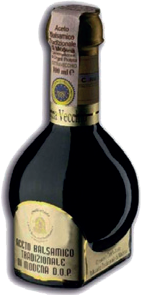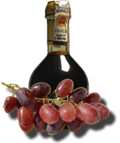True traditional balsamic vinegar (TBV) is a sweet and sour seasoning made from barrel-aged grape must, invented and produced in the Italian province of Modena and proteced with a P.D.O. / Protected Designation of Origin seal. The vinegar has been concentrated over a low flame (cooked must) and fermented slowly in a series of wooden barrels. Original balsamic contains no other ingredients than "cooked grape must" (100% mosto d'uva cotto in Italian). The grapes most commonly used are Lambrusco and Trebbiano.
In detail:
The balsamic vinegare is produced exclusively in the Region of Modena or Reggio Emilia from passionate culinary enterprises so called "Acetaie" with cooked grape must, through a three-step process: conversion of sugars to ethanol by yeast bacteria then oxidation of ethanol to acetic acid by acetic acid bacteria and, finally, at least 12 years of ageing in barrels of different woods that impart flavor and complexity.
Grapes intended for the production of Aceto Balsamico Tradizionale di Modena have to produce a must with a saccharometer reading of 15° (Oechsle degree) or more, and the maximum production, in the case of viticulture-only holdings, must not exceed 160 quintals per hectare, with a maximum yield in terms of must of 70%. Must intended for the production of the traditional balsamic vinegar is cooked at atmospheric pressure in open containers (Cottura). Cooking, using a direct source of heat, must last for 30 minutes at least while maintaining a temperature of 80° or more.
Blended musts or musts containing additives or substances may not be used. Please note, blending with wine vinegar is not allowed in the production of original traditional balsamic vinegar. After cooking, the must undergoes sugar and acetic fermentation in traditional vinegar production rooms (Acetaie tradizionali), using traditional methods which provide the necessary ventilation and range of natural temperatures. At least 12 years are needed for the optimum maturation, ageing and after care of Aceto Balsamico Tradizionale di Modena. As part of the process the cooked must is decanted several times into numbered and marked vats of different sizes made of wood that is typical of the Region, e.g. oak, juniper, cherry, mulberry and chestnut. When, in the opinion of the producer, the product satisfies the minimum requirements set out in the rules governing production it has to pass a series of analytical and organoleptic tests before being put in special bottles. Due to the ingredients and the production process, Aceto Balsamico Tradizionale is 100% gluten-free and vegan friendly.
 There are only two officially approved bottle shapes. The traditional balsamic vinegar from Modena P.D.O. is shipped only in 100ml bottles (3.4 oz/UK or 3.5 oz/UK) with the shape of a balsamic drop and made of white crystalline glass with a square base. The bottle was designed by Italdesign Giugiaro in 1988. For P.D.O balsamic vinegar from Reggio Emilia the offcially bottles are made in the shape of an inverted tulip.
There are only two officially approved bottle shapes. The traditional balsamic vinegar from Modena P.D.O. is shipped only in 100ml bottles (3.4 oz/UK or 3.5 oz/UK) with the shape of a balsamic drop and made of white crystalline glass with a square base. The bottle was designed by Italdesign Giugiaro in 1988. For P.D.O balsamic vinegar from Reggio Emilia the offcially bottles are made in the shape of an inverted tulip.
Labeling:
After bottling a numbered non-reusable label must be placed on each bottle in such a way as to prevent anyone from removing any of the contents without tearing it.
The label of a true traditional balsamic vinegar must contain the following wording: "Aceto Balsamico Tradizionale di Modena D.O.P" for a product from Modena or "Aceto Balsamico Tradizionale di Reggio Emilia D.O.P" for an original product from the province of Reggio Emilia.
Traditional balsamic vinegar of Modena P.D.O. is marketed as "traditional" after 12 years of aging and after 25 years as Traditional extra vecchio.
Traditional balsamic vinegar from Reggio Emilia P.D.O is labeld in three different qualities: argento (lobbster) with 240 - 269 testing points, aragosta (silver) with 270 - 299 testing points and oro (gold) with > 300 testing points.
True traditional balsamic vinegar has the following characteristica:
- Dark brown to reddish brown clear colour
- Thick and sticky syrupy consistency
- Pleasantly acid aroma displaying the smell of the types of wood barrels used
- Pleasantly sweet and sour, balanced of all organoleptic characteristics
Historical mention:
The earliest official record in which "balsamic" appears alongside the word "vinegar" dates back to the 18th century: a register of wine harvests and sales of the secret ducal cellars for 1747 judging from accounts of the court of the Duke of Modena, Alfonso I d' Este. The tradition of producing a very special balsamic vinegar in the area comprising the province of Modena must go back to 1508 at least. Other sources say, that in the year 1046, the emperor Henry III came to Italy to solve to the problems due to the election of three popes, during a stop in Duchy of Parma, request for gift a special vinegar, produced in Matilda of Tuscany castle in Canossa, that he had heard being the most perfect. In 1965 the Ministry of agriculture has defined the characteristics and methods (industrial or natrual) of vinegar production. Products made like today's traditional balsamic vinegar (TBV) were called natural balsamic vinegar.
The label "Aceto Balsamico Tradizionale di Modena D.O.P (traditional balsamic vinegar from Modena P.D.O) and Aceto Balsamico Tradizionale di Reggio Emilia D.O.P - ABTRE - (traditional balsamic vinegar from Reggio Emilia P.D.O) became officially on May 15th 2000 by the nomination and definition of the Ministry agricultural policies, food and forestry (Mipaaf) of Italy and the Council of the Union European, with a law and national protection adopted continental.
Latest News:
Every year, at the end of September, the Acetaie Aperte takes place in Spilamberto, near Modena. Many vinegar producers from the region open their balsamic farms on this day to introduce visitors to the world of traditional balsamic vinegar. To find out which Acetaie will be holding an open day this year on 09/24/2023, read our latest article on Acetaie Aperte. A week later, the next balsamic event takes place: the Mast Còt. Every year the beginning of the production of balsamic vinegar is celebrated with the first boiling of the grape must in the open air.
On June 6th, 2023 this year's competition 'Palio di San Giovanni' was held to choose the best balsamic vinegar from Modena in 2023. Over 1600 of the best vinegar producers took part in the Palio. The more than 20,000 samples were tested and evaluated by 284 tasters from the Consorteria dell'Aceto Balsamico Tradizionale di Modena Spilamberto. Read more about the show about the best balsamic vinegar.


Cooking with Traditional Balsamic Vinegar
Meesha Halm, 96 pages
$ (EN) 18,90
Order today!